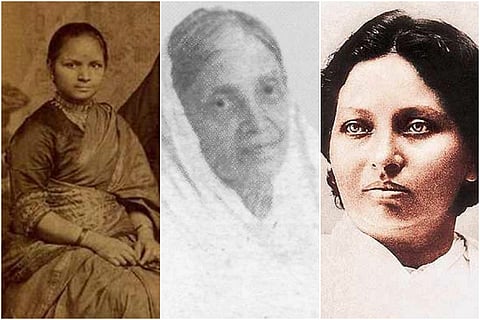

Venus holds numerous craters on its hellishly hot surface, all of which are named after women who have made contributions to their field. There are three craters that are named after Indian women who were supremely accomplished: the Joshee crater, the Jhirad crater, and the Medhavi crater.
The Joshee Crater is named after Anandi Gopal Joshi (1865–1887). She was the first woman of Indian origin to graduate with a degree in medicine in the United States. This made her one of the first female physicians from South Asia. Her story is as tragic as it is inspiring. As was prevalent at the time, she was given away early in her life, following the customs of child marriage. Her son was born when she was fourteen, but barely survived for ten days. The angst of losing her child led her to pursue a degree in the medial sciences. However, upon her celebrated return to Mumbai, tuberculosis claimed her life. All this before she had even turned 22.
Dr. Anandi Joshee, with her two batchmates from Women’s Medical College of Pennsylvania, both of whom were the first women from their country to come to America to obtain a medical degree
The Jhirad Crater is named after Jerusha Jhirad (1891–1984). Jhirad was also a physician. She was a member of the Bene Israel Jewish community, familiar to our grandparents as the "Native Jew". They are revered as descendants of the one of the Ten Lost Tribes, the ten historic/mythical communities who were forced to leave Israel when Damascus was sacked by Assyria in a biblical battle. Jhirad was the first woman to be awarded a Government of India scholarship to study in the United Kingdom, where she earned an M.D. in Obstetrics and Gynecology from the University of London. For her achievements and her efforts to improve medical education in India and advance the cause of woman doctors, she was awarded the MBE (Member of the British Empire) (Civil) by the British and the Padma Shri by the government of India in 1966.
Dr Jerusha Jhirad
The Medhavi Crater is named after Ramabai Medhavi (1858–1922), a Sanskrit scholar, women’s rights champion, and social activist. She was born to a Sanskrit scholar, and under her father’s tutelage, quickly became one herself. She earned the coveted title Pandita at the age of 20. Marrying at 22, she spoke out against child marriage and the troubles in the stifled and stigmatic life of widows. She went to Britain to obtain a medical degree, and then to the US to attend the graduation of her peer, the aforementioned Dr. Anandi Joshi. She founded the Arya Mahila Samaj in Pune after her husband’s death. She traveled widely through her life, becoming a poet and an author in the process. Being proficient in seven languages, she also translated the Bible to Marathi from Hebrew and Greek.
Pandita Ramabai, shortly after her move to London and conversion to Christianity
(This piece was originally published on TeamIndus Telemetry blog on Medium and has been republished here with permission.)